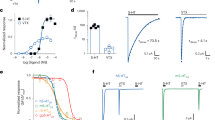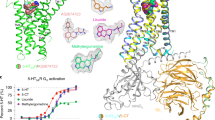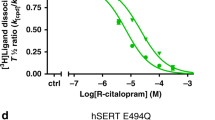Abstract
It has been proposed that the arylalkylamine, (-)pindolol, potentiates the therapeutic action of antidepressant drugs in humans by blockade of 5-HT1A autoreceptors. Its interactions at human 5-HT1A receptors have not, however, been directly characterized. Herein, we demonstrate that (-)pindolol exhibits nanomolar affinity at human 5-HT1A receptors expressed in Chinese Hamster Ovary cells (CHO-h5-HT1A; Ki = 6.4 nmol/L). In a functional test of receptor-mediated G-protein activation (stimulation of [35S]-GTPγS binding) (-)pindolol displays an efficacy of 20.3% relative to the endogenous agonist, 5-HT (=100%). (-)Pindolol also antagonizes 5-HT (100 nmol/L)-stimulated [35S]-GTPγS binding, reducing it to 19.8% of control binding. These data indicate that (-)pindolol acts as a (weak) partial agonist at CHO-h5-HT1A receptors and that it blocks the action of 5-HT at these sites.
Similar content being viewed by others
Main
The antidepressant properties of selective serotonin reuptake inhibitors (SSRI), such as fluoxetine, as well as other classes of antidepressant agents, involve an increase in the synaptic levels of 5-HT in corticolimbic structures. However, SSRIs also increase 5-HT levels at inhibitory 5-HT1A and 5-HT1B autoreceptors localized on serotoninergic cell bodies and terminals, respectively, thereby attenuating their postsynaptic effects (Artigas 1995; Gobert et al. 1997a). The progressive desensitization of these autoreceptors may, therefore, underlie the delay in onset of antidepressant action (Artigas 1995; Artigas et al. 1996). By mimicking desensitization, blockade of 5-HT1A and/or 5-HT1B autoreceptors enhances the increase in 5-HT levels provoked by SSRIs (Artigas et al. 1996; Gobert et al. 1997a; Hjorth and Auerbach 1996). Correspondingly, blockade of 5-HT1A autoreceptors by the arylalkylamine, (-)pindolol, may accelerate the antidepressant actions of SSRIs in humans (Artigas et al. 1996; Blier and Bergeron 1995). However, (-)pindolol's interaction with human 5-HT1A receptors has not, as yet, been directly characterized (Artigas 1995), complicating the interpretation of its actions. In this light, the present study examined the efficacy of (-)pindolol at recombinant 5-HT1A receptors heterologously expressed in a mammalian (CHO) cell line (Newman-Tancredi et al. 1992). Its actions were compared with those of 5-HT and the selective 5-HT1A receptor antagonist, WAY 100,135 (Fletcher et al. 1993), which also potentiates the increase in 5-HT levels provoked by SSRIs in rats (Hjorth and Auerbach 1996).
METHODS
Affinity at h5-HT1A receptors (Newman-Tancredi et al. 1992) was determined in competition experiments with [3H]-8-OH-DPAT (212 Ci/mmol, Amersham). CHO-h5-HT1A membranes (20 μg protein) were incubated (2.5 h, 22°C) in triplicate with competing ligands in a buffer containing HEPES 20 mmol/L (pH 7.5) and MgSO4 5 mmol/L. Nonspecific binding was defined with 10 μmol/L 5-HT. Efficacy was determined by measuring receptor-linked G-protein activation by [35S]-GTPγS binding as previously described (Newman-Tancredi et al. 1997). Briefly, CHO-h5-HT1A membranes (50 μg protein) were incubated (20 min, 22°C) in triplicate with agonist/antagonist in a buffer containing HEPES 20 mmol/L (pH 7.4), GDP 3 μmol/L, MgSO4 3 mmol/L, [35S]-GTPγS (1100 Ci/mmol, NEN) 0.1 nmol/L. Incubations were terminated by rapid filtration and radioactivity determined by liquid scintillation counting. Binding isotherms were analyzed by nonlinear regression, and results are expressed as mean ± SEM of at least three determinations.
RESULTS
(-)Pindolol, (±)pindolol, WAY 100,135, and 5-HT inhibited [3H]-8-OH-DPAT binding to h5-HT1A receptors with Ki values of 6.4 ± 1.2, 8.2 ± 1.7, 11.5 ± 2.3, and 0.82 ± 0.13 nmol/L respectively (Figure 1A ). In a measure of receptor-mediated G-protein activation, (-)pindolol stimulated [35S]-GTPγS binding with an EC50 of 11.5 ± 4.5 nmol/L and an Emax of 20.3 ± 2.1% relative to 5-HT (Emax = 100%, EC50 = 15 ± 3.8 nmol/L). (-)Pindolol antagonized the stimulation of [35S]-GTPγS binding induced by 5-HT (100 nmol/L), reducing it to the same level of binding as in the presence of (-)pindolol alone (19.8 ± 3.7%, IC50 = 263 ± 42 nmol/L; Figure 1B). WAY 100,135 did not modify [35S]-GTPγS binding but reduced 5-HT (100 nmol/L) stimulated [35S]-GTPγS binding to basal levels with an IC50 of 119 ± 24 nmol/L. In control experiments, (-)pindolol (1 μmol/L)-induced [35S]-GTPγS binding was blocked by the selective 5-HT1A receptor antagonist, WAY 100,635 (10 μmol/L; Newman-Tancredi et al. 1996) reducing it to 3.6 ± 4.2% of that induced by 5-HT. Basal [35S]-GTPγS binding to untransfected CHO cells (9760 ± 850 dpm) was not altered by 10 μmol/L 5-HT (10230 ± 1190 dpm) or by 10 μmol/L (-)pindolol (9780 ± 910 dpm).
(A): Competition binding isotherms for [3H]-8-OH-DPAT binding at h5-HT1A receptors stably expressed in CHO cells. (B and C): Effects of (-)pindolol and WAY 100,135 (WAY) alone and in the presence of 5-HT (100 nmol/L) on stimulation of [35S]-GTPγS binding to CHO-h5-HT1A membranes, expressed as a percentage of the maximal binding given by 5-HT (10 μmol/L). Points shown are means of triplicate determinations from representative experiments.
DISCUSSION
The present data show that (-)pindolol interacts with recombinant 5-HT1A receptors with high affinity (nanomolar Ki value) comparable to that of WAY 100,135. However, in contrast to the endogenous (full) agonist, 5-HT, and the antagonist, WAY 100,135, (-)pindolol elicits a modest (ca. 20%) activation of [35S]-GTPγS binding. (-)Pindolol concentration-dependently reduced 5-HT-induced [35S]-GTPγS binding to a level comparable to that elicited by (-)pindolol alone. It is concluded that (-)pindolol behaves as a weak partial agonist at CHO-h5-HT1A receptors. These in vitro data at recombinant human 5-HT1A receptors are consistent with a report of weak partial agonist properties of (-)pindolol at rat 5-HT1A receptors (De Vivo and Maayani 1990) and results from in vivo studies in humans, where (-)pindolol acted as a weak partial agonist in modulation of core temperature, corticosterone, and prolactin levels (for review, see Meltzer and Maes 1996).
As discussed elsewhere (Newman-Tancredi et al. 1997). CHO-h5-HT1A cell membranes constitute a model of postsynaptic 5-HT1A receptors, with agonist efficacies that correspond to those observed for agonist activation of hippocampal 5-HT1A sites (e.g., Odagaki and Fuxe 1995). In contrast, at presynaptic 5-HT1A receptors, which display high density and receptor reserve, the efficacy of (-)pindolol may be amplified (Meller et al. 1990). Indeed, at high doses, (-)pindolol behaves as a partial agonist in several models thought to reflect activation of autoreceptor-mediated activity in animals and, possibly, in humans (Meltzer and Maes 1996; Hjorth and Auerbach 1996).
Antagonism of postsynaptic 5-HT1A receptors and an agonist action at 5-HT1A autoreceptors would be inconsistent with a potentiation of the activity of serotoninergic neurones by (-)pindolol either alone or in combination with SSRIs (Redrobe et al. 1996; Blier et al. 1997). However, in dialysis studies in conscious animals, (-)pindolol fails to affect, or actually increases, postsynaptic levels of 5-HT, consistent with antagonist actions at 5-HT1A autoreceptors (Hjorth and Auerbach 1996). Further, as mentioned above, (-)pindolol facilitates the influence of SSRIs upon postsynaptic 5-HT levels, whereas the partial agonist, buspirone, inhibits the actions of SSRIs (Gobert et al. 1997b). In addition, it has been suggested, on the basis of electrophysiological studies, that low doses (2.5 mg PO) of (-)pindolol may preferentially antagonize raphe-localized rather than hippocampal 5-HT1A receptors in rats (Blier et al. 1997). Indeed, the induction of corticosterone secretion observed in humans (which may reflect agonist activity at postsynaptic receptors) is seen at high doses of (-)pindolol (30.0 mg PO; Meltzer and Maes 1996). The present data show that the intrinsic activity of (-)pindolol at human receptors is markedly lower than that of 5-HT, a relationship likely to hold true for both pre- and postsynaptic sites. Thus, even if (-)pindolol itself exerts partial agonist actions at 5-HT1A autoreceptors, it will reduce their stimulation by endogenous 5-HT. Hence, (-)pindolol may increase the ability of SSRIs to enhance postsynaptic 5-HT levels and, thereby, their antidepressant actions.
In conclusion, the present data, although globally in accordance with the hypothesis that (-)pindolol increases the antidepressant effects of SSRIs by antagonism of 5-HT at inhibitory 5-HT1A autoreceptors, highlight the need for further investigation. Indeed, (-)pindolol possesses marked affinity at β-adrenergic and 5-HT1B receptors, in addition to weak partial agonist activity at 5-HT1A receptors. Therefore, clinical studies with selective and “neutral” 5-HT1A receptor antagonists will be required to confirm that blockade of 5-HT1A autoreceptors genuinely enhances the therapeutic actions of SSRIs and other antidepressant agents.
References
Artigas F . (1995): Pindolol, 5-hydroxytryptamine and antidepressant augmentation. Arch Gen Psychiatry 52: 969–970
Artigas F, Romero L, De Montigny C, Blier P . (1996): Acceleration of the effect of selected antidepressant drugs in major depression by 5-HT1A receptor antagonists. Trends Neurosci 19: 378–383
Blier P, Bergeron R . (1995): Effectiveness of pindolol with selected antidepressant drugs in the treatment of major depression. J CLin Psychopharmacol 15: 217–222
Blier P, Bergeron R, De Montigny C . (1997): Selective activation of postsynaptic 5-HT1A receptors induces rapid antidepressant response. Neuropsychopharmacology 16: 333–338
De Vivo M, Maayani S . (1990): Stimulation and inhibition of adenylyl cyclase by distinct 5-hydroxytryptamine receptors. Biochem Pharmacol 40: 1551–1558
Fletcher A, Bill DJ, Bill SJ, Cliffe IA, Dover GM, Forster EA, Haskins TJ, Jones D, Mansell HL, Reilly Y . (1993): WAY 100,135: A novel selective antagonist at presynaptic and postsynaptic 5-HT1A receptors. Eur J Pharmacol 237: 283–291
Gobert A, Rivet J-M, Cistarelli L, Millan MJ . (1997a): Potentiation of the fluoxetine-induced increase in dialysate levels of serotonin (5-HT) in the frontal cortex of freely moving rats by combined blockade of 5-HT1A and 5-HT1B receptors with WAY 100,635 and GR 127,935. J Neurochem 68: 1159–1163
Gobert A, Rivet J-M, Cistarelli L, Millan MJ . (1997b): Buspirone enhances duloxetine- and fluoxetine-induced increases in dialysate levels of dopamine and noradrenaline, but not serotonin, in the frontal cortex of freelymoving animals. J Neurochem 68: 1326–1329
Hjorth S, Auerbach SB . (1996): 5-HT1A autoreceptors and the mode of action of selective serotonin reuptake inhibitors (SSRI). Behav Brain Res 73: 281–283
Meller E, Goldstein M, Bohmaker K . (1990): Receptor reserve for 5-hydroxytryptamine1A–mediated inhibition of serotonin synthesis: Possible relationship to anxiolytic properties of 5-hydroxytryptamine1A agonists. Mol Pharmacol 37: 231–237
Meltzer HY, Maes M . (1996): Effect of pindolol on hormone secretion and body temperature: Partial agonist effects. J Neural Transm 103: 77–88
Newman-Tancredi A, Wootton R, Strange PG . (1992): High-level stable expression of recombinant 5-HT1A 5-hydroxytryptamine receptors in Chinese Hamster Ovary cells. Biochem J 285: 933–938
Newman-Tancredi A, Conte C, Chaput C, Verrièle L, Millan MJ . (1996): S 15535 and WAY 100,635 antagonise 5-HT–stimulated [35S]-GTPγS binding at cloned human 5-HT1A receptors. Eur J Pharmacol 307: 107–111
Newman-Tancredi A, Conte C, Chaput C, Verrièle L, Millan MJ . (1997): Agonist and inverse agonist efficacy at human recombinant serotonin 5-HT1A receptors as a function of receptor: G-protein stoichiometry. Neuropharmacology 36: 451–459
Odagaki Y, Fuxe K . (1995): Pharmacological characterisation of the 5-hydroxytryptamine-1A receptor-mediated activation of high-affinity GTP hydrolysis in rat hippocampal membranes. J Pharmacol Exp Ther 274: 337–344
Redrobe JP, MacSweeny CP, Bourin M . (1996): The role of 5-HT1A and 5-HT1B receptors in antidepressant drug actions in the mouse forced swimming test. Eur J Pharmacol 318: 213–220
Author information
Authors and Affiliations
Rights and permissions
About this article
Cite this article
Newman-Tancredi, A., Chaput, C., Gavaudan, S. et al. Agonist and Antagonist Actions of (-)Pindolol at Recombinant, Human Serotonin1A (5-HT1A) Receptors. Neuropsychopharmacol 18, 395–398 (1998). https://doi.org/10.1016/S0893-133X(97)00169-3
Received:
Accepted:
Issue Date:
DOI: https://doi.org/10.1016/S0893-133X(97)00169-3
Keywords
This article is cited by
-
The Serotonin 1A (5-HT1A) Receptor as a Pharmacological Target in Depression
CNS Drugs (2023)
-
Neurokinin1 Antagonists Potentiate Antidepressant Properties of Serotonin Reuptake Inhibitors, Yet Blunt Their Anxiogenic Actions: A Neurochemical, Electrophysiological, and Behavioral Characterization
Neuropsychopharmacology (2009)
-
Blockade of 5-HT1A Receptors by (±)-Pindolol Potentiates Cortical 5-HT Outflow, but not Antidepressant-Like Activity of Paroxetine: Microdialysis and Behavioral Approaches in 5-HT1A Receptor Knockout Mice
Neuropsychopharmacology (2006)
-
A Mathematical Model for Paroxetine Antidepressant Effect Time Course and Its Interaction with Pindolol
Journal of Pharmacokinetics and Pharmacodynamics (2005)
-
Preferential 5-HT1A Autoreceptor Occupancy by Pindolol is Attenuated in Depressed Patients: Effect of Treatment or an Endophenotype of Depression?
Neuropsychopharmacology (2004)




